【英语新教材】4.3 Discovering Useful Structure 导学案(2)-人教版高中英语必修第二册
- 格式:docx
- 大小:56.65 KB
- 文档页数:7
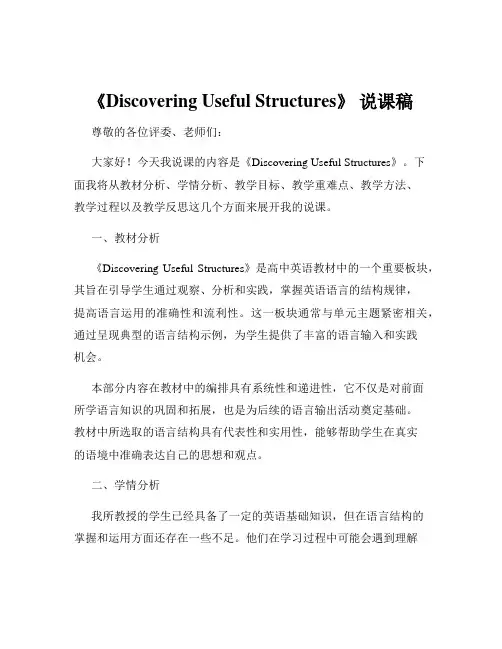
《Discovering Useful Structures》说课稿尊敬的各位评委、老师们:大家好!今天我说课的内容是《Discovering Useful Structures》。
下面我将从教材分析、学情分析、教学目标、教学重难点、教学方法、教学过程以及教学反思这几个方面来展开我的说课。
一、教材分析《Discovering Useful Structures》是高中英语教材中的一个重要板块,其旨在引导学生通过观察、分析和实践,掌握英语语言的结构规律,提高语言运用的准确性和流利性。
这一板块通常与单元主题紧密相关,通过呈现典型的语言结构示例,为学生提供了丰富的语言输入和实践机会。
本部分内容在教材中的编排具有系统性和递进性,它不仅是对前面所学语言知识的巩固和拓展,也是为后续的语言输出活动奠定基础。
教材中所选取的语言结构具有代表性和实用性,能够帮助学生在真实的语境中准确表达自己的思想和观点。
二、学情分析我所教授的学生已经具备了一定的英语基础知识,但在语言结构的掌握和运用方面还存在一些不足。
他们在学习过程中可能会遇到理解困难、记忆混淆等问题,但同时也具有较强的好奇心和求知欲,愿意积极参与课堂活动,通过合作学习来解决问题。
部分学生在语法学习上可能存在畏难情绪,需要教师采用生动有趣的教学方法,激发他们的学习兴趣,帮助他们树立学习信心。
此外,学生的个体差异较大,在教学中要关注不同层次学生的需求,提供多样化的学习任务和指导。
三、教学目标1、知识目标(1)学生能够理解和掌握本单元所涉及的重点语言结构,如各种时态、语态、从句等。
(2)能够准确识别和运用这些语言结构进行句子的书写和表达。
2、能力目标(1)通过观察和分析语言结构的示例,培养学生的语言感知和归纳能力。
(2)通过练习和实践,提高学生运用语言结构进行口头和书面表达的能力。
3、情感目标(1)激发学生对英语语法学习的兴趣,消除他们对语法学习的恐惧心理。
(2)培养学生合作学习的意识和能力,增强他们的团队精神。


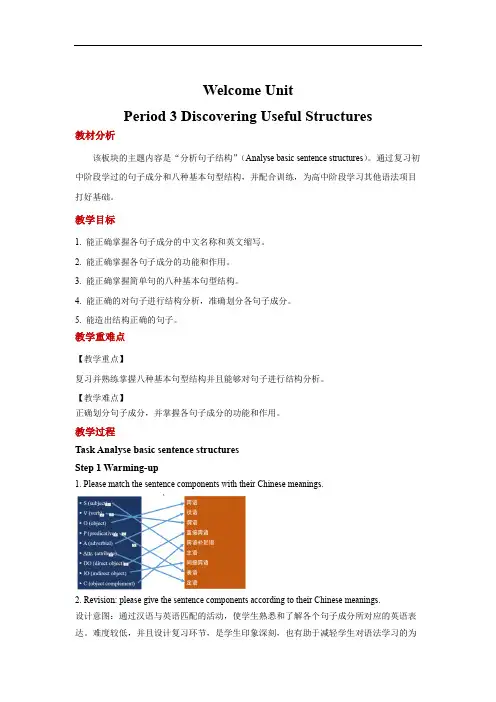
Welcome UnitPeriod 3 Discovering Useful Structures教材分析该板块的主题内容是“分析句子结构”(Analyse basic sentence structures)。
通过复习初中阶段学过的句子成分和八种基本句型结构,并配合训练,为高中阶段学习其他语法项目打好基础。
教学目标1. 能正确掌握各句子成分的中文名称和英文缩写。
2. 能正确掌握各句子成分的功能和作用。
3. 能正确掌握简单句的八种基本句型结构。
4. 能正确的对句子进行结构分析,准确划分各句子成分。
5. 能造出结构正确的句子。
教学重难点【教学重点】复习并熟练掌握八种基本句型结构并且能够对句子进行结构分析。
【教学难点】正确划分句子成分,并掌握各句子成分的功能和作用。
教学过程Task Analyse basic sentence structuresStep 1 Warming-up1. Please match the sentence components with their Chinese meanings.2. Revision: please give the sentence components according to their Chinese meanings.设计意图:通过汉语与英语匹配的活动,使学生熟悉和了解各个句子成分所对应的英语表达。
难度较低,并且设计复习环节,是学生印象深刻,也有助于减轻学生对语法学习的为难情绪。
Step 2 Identifying definition1.句子成分定义:组成句子的各个部分叫做句子成分。
必须部分:主语、谓语必要部分:宾语、表语和补足语辅助部分:定语、状语2. Summary3. Work on Acitivity1. Study the sentence structures.There are _____ types of basic sentence structures.设计意图:明确句子成分和句子类型的相关定义。
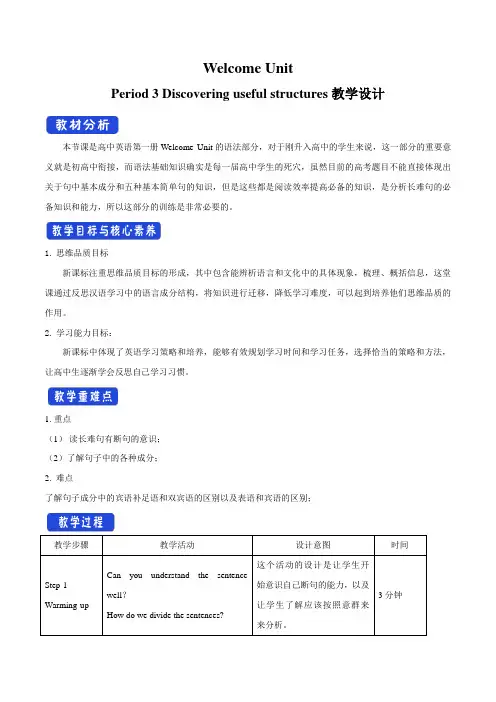
Welcome Unit
Period 3 Discovering useful structures教学设计
本节课是高中英语第一册Welcome Unit的语法部分,对于刚升入高中的学生来说,这一部分的重要意义就是初高中衔接,而语法基础知识确实是每一届高中学生的死穴,虽然目前的高考题目不能直接体现出关于句中基本成分和五种基本简单句的知识,但是这些都是阅读效率提高必备的知识,是分析长难句的必备知识和能力,所以这部分的训练是非常必要的。
1.思维品质目标
新课标注重思维品质目标的形成,其中包含能辨析语言和文化中的具体现象,梳理、概括信息,这堂课通过反思汉语学习中的语言成分结构,将知识进行迁移,降低学习难度,可以起到培养他们思维品质的作用。
2.学习能力目标:
新课标中体现了英语学习策略和培养,能够有效规划学习时间和学习任务,选择恰当的策略和方法,让高中生逐渐学会反思自己学习习惯。
1.重点
(1)读长难句有断句的意识;
(2)了解句子中的各种成分;
2. 难点
了解句子成分中的宾语补足语和双宾语的区别以及表语和宾语的区别;。
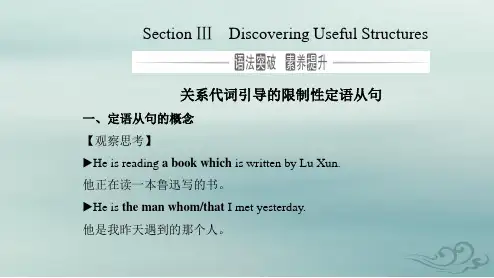
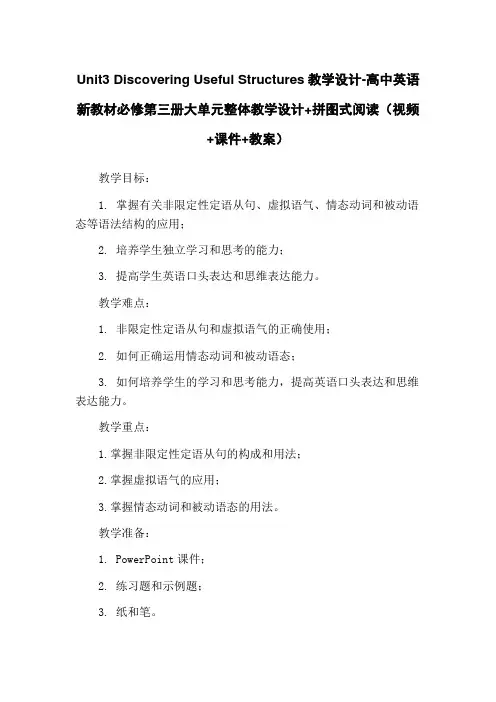
Unit3 Discovering Useful Structures教学设计-高中英语新教材必修第三册大单元整体教学设计+拼图式阅读(视频+课件+教案)教学目标:1. 掌握有关非限定性定语从句、虚拟语气、情态动词和被动语态等语法结构的应用;2. 培养学生独立学习和思考的能力;3. 提高学生英语口头表达和思维表达能力。
教学难点:1. 非限定性定语从句和虚拟语气的正确使用;2. 如何正确运用情态动词和被动语态;3. 如何培养学生的学习和思考能力,提高英语口头表达和思维表达能力。
教学重点:1.掌握非限定性定语从句的构成和用法;2.掌握虚拟语气的应用;3.掌握情态动词和被动语态的用法。
教学准备:1. PowerPoint课件;2. 练习题和示例题;3. 纸和笔。
教学过程:Step 1 导入(5分钟)通过展示一些生动的图片、表情包和视频向学生介绍本堂课的话题和主要内容,以激发学生的学习兴趣和主动性。
Step 2 了解学生已有的语法知识(10分钟)通过问答和小组讨论的方式,了解学生对非限定性定语从句、虚拟语气、情态动词和被动语态等语法结构的理解和应用情况。
Step 3 非限定性定语从句的学习(20分钟)a. 介绍非限定性定语从句的定义、构成和用法;b. 解释定语从句与非限定性定语从句的区别;c. 配合PPT展示相关例句,让学生逐步理解和掌握非限定性定语从句的应用;d. 给出练习题,让学生进行运用和巩固。
Step 4 虚拟语气的学习(20分钟)a. 介绍虚拟语气的定义、构成和用法;b. 解释虚拟语气在现在和过去的运用;c. 配合PPT常用虚拟语气展示相关例句。
让学生逐步理解和掌握虚拟语气的应用;d. 给出练习题,让学生进行巩固。
Step 5 情态动词和被动语态的学习(20分钟)a. 介绍情态动词的定义、构成和用法;b. 解释被动语态的构成和用法;c. 配合PPT展示相关例句。
让学生逐步理解和掌握情态动词和被动语态的应用;d. 给出练习题,让学生进行运用和巩固。

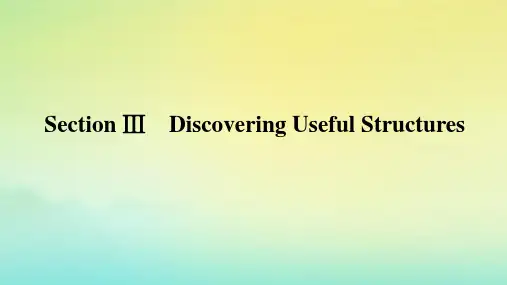

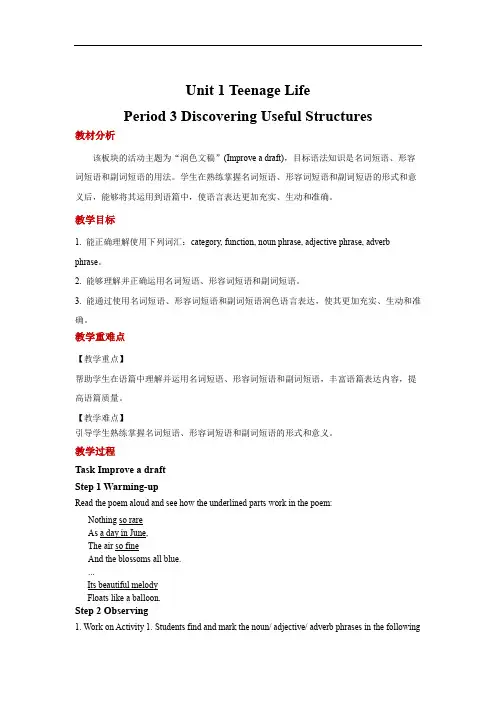
Unit 1 Teenage LifePeriod 3 Discovering Useful Structures教材分析该板块的活动主题为“润色文稿”(Improve a draft),目标语法知识是名词短语、形容词短语和副词短语的用法。
学生在熟练掌握名词短语、形容词短语和副词短语的形式和意义后,能够将其运用到语篇中,使语言表达更加充实、生动和准确。
教学目标1. 能正确理解使用下列词汇:category, function, noun phrase, adjective phrase, adverb phrase。
2. 能够理解并正确运用名词短语、形容词短语和副词短语。
3. 能通过使用名词短语、形容词短语和副词短语润色语言表达,使其更加充实、生动和准确。
教学重难点【教学重点】帮助学生在语篇中理解并运用名词短语、形容词短语和副词短语,丰富语篇表达内容,提高语篇质量。
【教学难点】引导学生熟练掌握名词短语、形容词短语和副词短语的形式和意义。
教学过程Task Improve a draftStep 1 Warming-upRead the poem aloud and see how the underlined parts work in the poem:Nothing so rareAs a day in June,The air so fineAnd the blossoms all blue....Its beautiful melodyFloats like a balloon.Step 2 Observing1. Work on Activity 1. Students find and mark the noun/ adjective/ adverb phrases in the followingsentences:(1) The first week was a little confusing.(2) The building is so big that I’m completely lost.(3) The kids over there are putting something on a round paper plate....2.Students observe the sentences again and state the phrases’ functions.设计意图:该环节让学生通过观察例句,发现句子中的目标短语结构,进一步感知其在语言表达中所起到的作用。
必修一Unit 5 Discovering Useful Structures课题UNIT 5LANGUAGES AROUND THE WORLDPeriod 3 Discovering Useful Structures学科英语班级授课教师教学目标By the end of this section, students will be able to:1. identify and summarise the function of relative adverbs in restrictive relative clauses;2. describe one of their favourite memories with restrictive relative clauses.教学主题该板块的教学主题是“描述你喜欢的事物”(Describe your favourite things)。
要求学生用限制性定语从句对自己喜欢的事物进行具体的描述,以力求语言更丰富、准确,在提高英语语言组织能力的同时发展逻辑思维能力。
教学重点1.引导学生识别句子中由关系副词引导的定语从句,能够理解“介词+which”引导定语从句的用法;2.引导学生运用由关系副词以及“介词+which”引导的定语从句进行造句。
教学难点引导学生准确得体的运用定语从句表达自己对事物的喜好以及原因。
教学内容与过程Lead-in老师通过展示一些由关系代词引导的定语从句的句子,带领学生回顾上单元所学习过的限制性定语从句的知识,为接下来的教学活动做好铺垫。
Step 1 Presentation(1)学生阅读活动1中的句子,画出定语从句,熟悉该种从句的结构形式,然后讨论从句在整个句子中所起的作用(对前面所修饰的事物进行限制、补充和说明)。
教师也可在此解释一下所修饰的先行词和关系副词在句子中的语法功能。
之后学生浏览本单元的主篇阅读,找出类似的限制性定语从句。
[新知导引]祈使句+附加疑问部分Come along with me, will you?/can you?/won't you?/can't you?Don't make any noise, will you?三、附加疑问句的回答附加疑问句的答语与一般疑问句类似,注意其与汉语表达习惯的差异。
如:(1)A:The 29th Olympic Games were held in Beijing, weren't they?B:Yes, they were.(Yes, that's right.)(2)A:Michael Jordan started to play basketball in college, didn't he?B:No, he didn't. He first played in a team in senior high school.(3)A:David has been to a boxing match, hasn't he?B:No, he hasn't. He always watches boxing on TV.(4)A:You can't cook, can you?你不会做饭,是吗?B:Yes, I can. I'm good at cooking.不,我会。
我做饭很好。
四、变附加疑问句时应注意的问题1.当陈述部分含有seldom, hardly, never, rarely, few, little, nowhere, nothing等否定词或半否定词时,简短问句应用肯定句式。
①She seldom goes to the cinema, does she?她很少去看电影,是吗?②He has never been to London, has he?他从没去过伦敦,是吗?2.当陈述部分中表示否定意义的词为含有im-,in-,dis-,un-等否定前缀或-less等否定后缀的词时,应把陈述部分视为肯定句,简短问句要用否定式。
Unit 4 History and TraditionsPeriod 3 Discovering Useful Structure导学案1.Learn the structure of the present continuous passive voice and its functions.2.Learn to change the sentences with the present continuous tense into the sentences with the present continuous passive voice.3.Learn to write sentences with the present continuous tense flexibly according to the context.1.Learn the structure of the present continuous passive voice and its functions.2.Learn to change the sentences with the present continuous tense into the sentences with the present continuous passive voice.3.Learn to write sentences with the present continuous tense flexibly according to the context.Step 1. Observe the following sentences, and answer the question:What is the relationship between the past participle and the nouns ?1.Most people just use the shortened name: “the United Kingdom” or “the UK”.2.3.位置区别:例1中,shortened在名词______,例2中,known as 在名词______。
所以,我们可以得出结论:_______________________________________________________________。
句子成分:例1和例2,分词和分词短语都用来修饰______,做定语;例3 名词castles 是作had的宾语,所以built是对名词castles进行补充说明,做__________(简称宾补)。
Step 2 Practice1.分析过去分词在句子中的成分1) The new product finally passed the required test.2) It is a house built by the Romans.3) He got his tooth pulled out yesterday.4)Unfortunately he had his leg broken yesterday.2.改写过去分词1). tired visitors--- visitors________ of the long wait2). a well-organised trip---a trip______ well by my workplace3)beautifully dressed star--- stars __________ beautifully at the eventStep 3. More as the attribute过去分词作定语的时态和语态意义1.及物动词的过去分词作定语通常表示被动和完成, 即被修饰词通常是过去分词所表示的动作的承受者, 且该动作已经完成。
I don’t like the book written by Martin(=which was written by Martin). 我不喜欢马丁写的这部书。
Our class went on a trip organized by our school(=which was organized by our school) last Monday.上周一我们班参加了一次学校组织的旅行。
2.不及物动词的过去分词作定语仅表示完成, 不表示被动。
The fallen leaves of the wood cover the ground when in fall. 秋天时, 小树林的落叶覆盖着地面。
The risen sun is shining brightly in the morning. 早上已升起的太阳正明亮地闪耀着。
3.过去分词(短语)作非限制性定语, 相当于非限制性的定语从句, 用来补充说明被修饰词的情况,通常用逗号与主句隔开。
The bridge, built last year(=____________________), is in use now.这座桥, 去年建成, 现在已通行。
Paper cuts, used for religious purposes(=w______________________________), can be bought in the store. 用于宗教目的的剪纸可以在这家商店里买到。
现在分词与过去分词作定语的区别1.语态上不同: 现在分词表示主动意义, 过去分词多表示被动意义。
The running water (=The water which runs)in the river is very clear. 河里的流水很清澈。
Nine out of ten women interviewed (=____________________)about the product said they liked it.就这个产品被采访的十位妇女中有九位说她们喜欢这个产品。
2.时间关系上不同: 现在分词表示正在进行的动作, 而过去分词表示已经完成的动作。
We are all living in a changing world(=____________________).我们都生活在正在发生变化的世界里。
The changed world (=____________________) surprised him. 已经变化了的世界令他吃惊。
Step 4. More as the object complement1. 用于feel, find, hear, notice, see, smell, observe, watch, think等表示感觉或心理状态的动词后作宾语补足语。
Many passers-by saw a tree beside the street knocked down by a car yesterday.昨天很多路人看见路边的一棵树被一辆小汽车撞倒了。
When he woke up in the hospital, he found himself surrounded by doctors and nurses.当他在医院醒来时, 他发现自己被医生和护士包围着。
总结起来,其结构为:_________________________________2. 用于get, have, make, keep, leave等使役动词后作宾语补足语。
He spoke English slowly, and tried to make himself understood while traveling abroad.在国外旅行期间, 他说英语的语速很慢, 尽力让人们理解自己的意思。
When he was working, he liked keeping the door of his room closed.当他工作时, 他喜欢关着房间的门。
He wants to have/get his eyes examined tomorrow.他明天想去检查眼睛。
He narrowly had his legs broken while he was riding a horse the other day.几天前当他骑马时, 他的腿差点摔断。
总结起来,其结构为:_________________________________Step 5 Practice一、完成下列句子。
1.Judy and I _______________(把车停下来(park))in an underground car Park near Trafalgar Square,where we could ______________________(让我们的车充电(charge)).2.When we finally reached the service desk to ask for audio guides, we heard it ___________ thatthere were no audio guides____________(留下,剩下).3.We__________________________(发现自己对...很惊讶)the large number of visitors and theamount of noise at the entrance of the National Gallery.4.Judy ____________________(眼神专注于)Van Gogh’s Sunflowers. It was hard to approach thepainting as there were so many people around.5.She ____________________(把这幅画的复制品装箱(box))to ensure that it was delivered safely.二、用过去分词对下列句子进行改写。
1.Loch Ness was surrounded by beautiful natural landscape, which made it look amazing.2.Carl and his friend stayed with a generous family who offered them bread with butter and honey thatwas homemade.3.The family’s ancestors once attended to soldiers who were wounded in the First World War.4.The young people were attracted by the legend of Loch Ness. They watched over the lake with theircameras and binoculars, which were positioned on the hill.答案:Step 1. Observe the following sentences, and answer the question:What is the relationship between the past participle and the nouns ?1.Most people just use the shortened name: “the United Kingdom” or “the UK”.2.3.位置区别:例1中,shortened在名词前,例2中,known as 在名词后面。